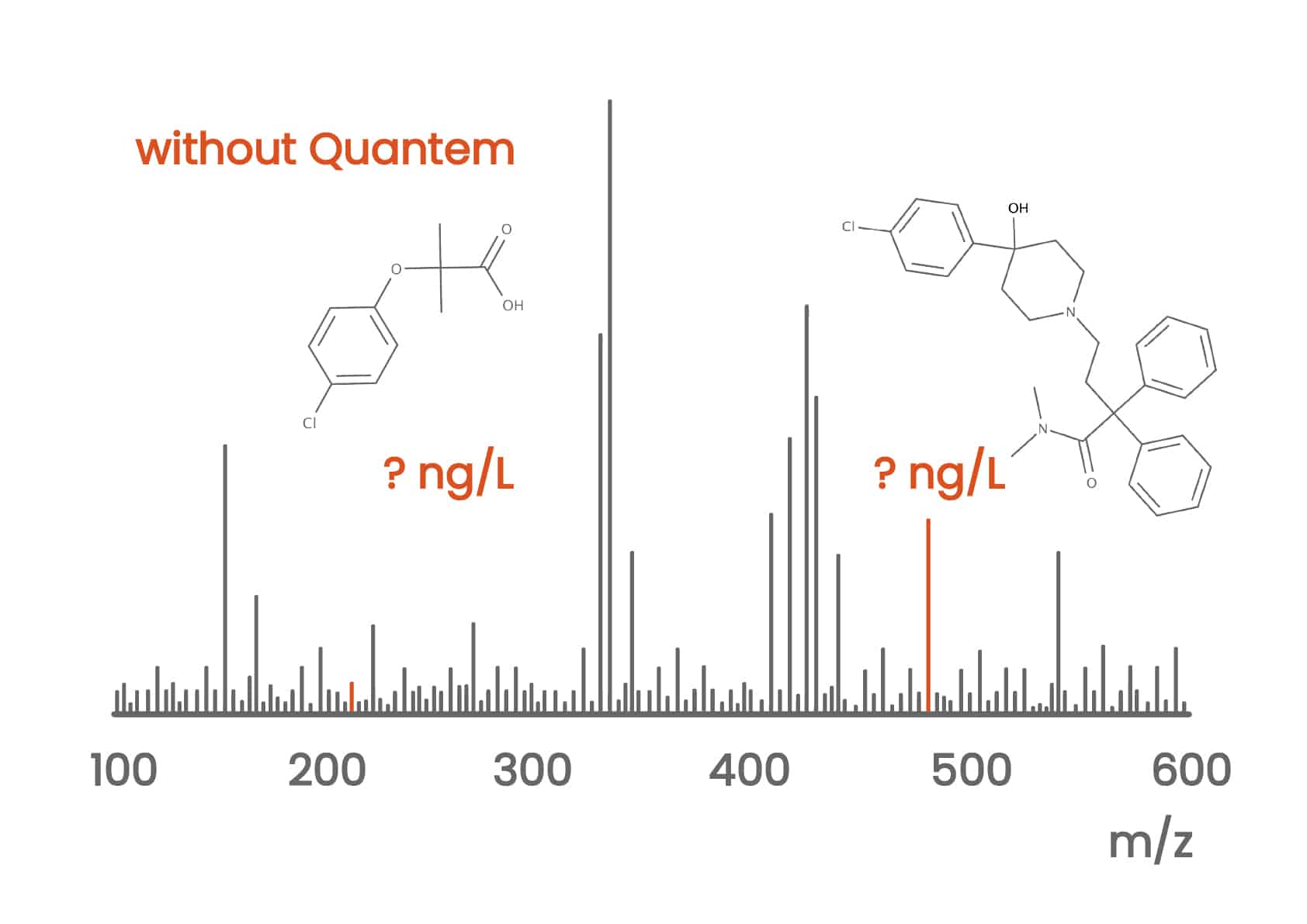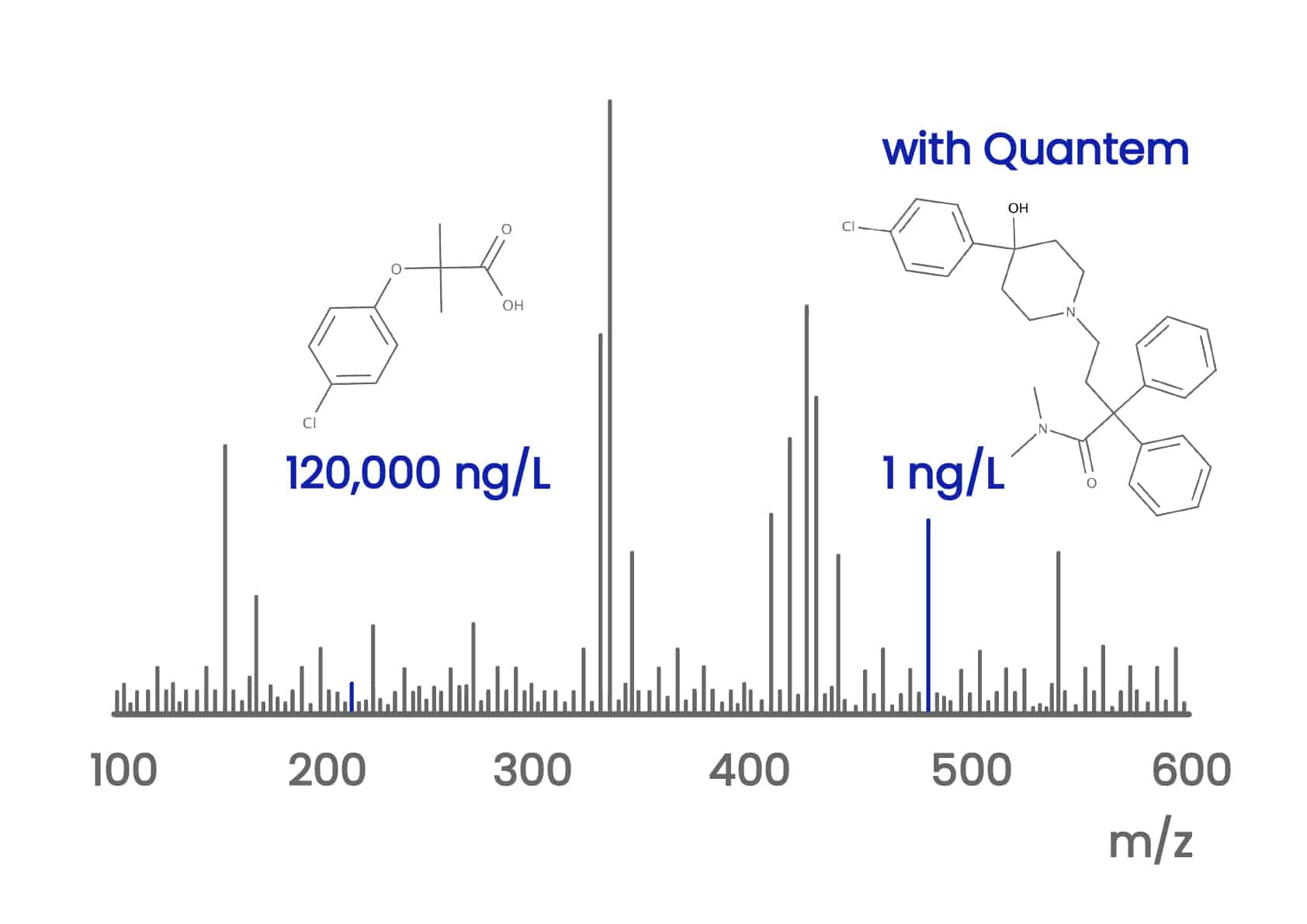Without Quantem
Compounds are identified, but their concentrations remain unknown.
Compounds are identified, but their concentrations remain unknown.


Identified compounds are quantified with Quantem.
When analyzing your samples for safety, you must evaluate contaminants like pesticides, pharmaceuticals, their transformation products, etc. to assess toxicological risks. Using suspect or non-target screening is an effective approach, allowing you to detect peaks and identify compounds holistically. However, estimating the concentration from MS signals of close-eluting or similar compounds or using single point calibration can result in errors as large as tens of millions of times, making it challenging to assess the actual risk accurately.
Before you invest in standards for calibration and embark on time-consuming method development, turn to Quantem. Our software utilizes a robust computational model, derived from tens of thousands of measurements, to swiftly estimate the concentration of any small compound with an average error of 3 times. This accuracy provides sufficient certainty to promptly determine the next steps, including whether detailed quantification of the suspect compound is necessary, or whether Quantem estimation indicates that the concentration is too low to pose a risk.
Estimate concentration for any detected contaminant.
Concentration estimation is done in minutes which allows fast decision-making.
The tool is easy and intuitive, which makes it user-friendly for any lab member.
You will not have to make any extra analysis, just the data you already have.
Structure of your suspect compound.
Retention time and peak area of the detected compound.
Solvent, additives and gradient program details used in this analysis.
Data of any 5 compounds with know concentration measured with the same method (e.g. QA/QC mix).
Jaanus is undoubtedly a world-leading expert in ionization efficiencies and has over ten years of experience in data science. As the mastermind behind Quantem software, he leads our business development and continuously enhances our concentration estimation model. Outside of work, Jaanus’s dedication to marathon running exemplifies his persistence and determination, qualities he also applies to professional challenges.
Mari leads the operational and marketing strategies at Quantem, skillfully managing everything from visuals, copywriting and social media to day-to-day operations. With a background in analytical chemistry and mass spectrometry, she is also assisting sales. Mari also manages finances and is the heart of the team by organizing team-building events. Her passion for folk dancing strengthens her team spirit, making her essential in building a collaborative workplace.
Karl Kaupmees bridges the gap between research and technology with a strong background in analytical chemistry and expertise in handling big data. Holding a PhD in chemistry focused on solvent effects and molecular modeling, and currently completing a Master’s in IT specializing in data science and software product management, Karl leads our product strategies and makes sure our products are cutting-edge, robust and easy to use.
Piia is our industry advisor, having hands-on experience with Quality Control and Quality Assurance mostly in the pharmaceutical industry. With insider insights working in the intersection of product development and business, she brings us valuable advice in business development. What is more, during her PhD she expanded the Quantem model applications to biological matrices, connected positive and negative mode ESI.
Anneli is a world-leading expert in the fundamentals of mass spectrometry, combining her deep knowledge with machine learning approaches to build novel solutions for chemists worldwide. As our academic advisor, she provides critical insights into scientific advancements. She is a Professor at Stockholm University, a prestigious ERC Consolidator Grant holder and in 2018 named to the Top 40 Under 40 Power List by the Analytical Scientist.
Yes, Quantem model takes into account the variability between instruments making the prediction result specific to every client. This is established since Quantem Model is developed and tested on many different intruments including Agilent, Thermo, Waters, Sciex and Bruker.
Yes, Quantem model takes into account the variability between analysis methodologies making the prediction result specific to your analysis. This is established since Quantem Model is developed and tested under many different conditions.
Quantem Model is applicable for:
Yes, Quantem model takes into account the variability between analytes and samples making the prediction result specific to your analysis. This is established since Quantem Model is developed and tested in different matrices with thousands of diverse analytes.
Quantem Model is applicable for:
For the quantification with Quantem, you will need 5 compounds with known concentration that are measured under the same conditions as the analytes. We recommend to choose 5 or more compounds that are evenly divided over the chromatogram and have as different ionization efficiency (IE) values as possible. The frequency of measuring these compounds (e.g every run/day/week) depends on your application. You can choose and use your in-house compounds, or we can provide a mixture that suits your needs.
Yes and no.
Yes, Quantem model uses SMILES code to predict the concentration, thus you will have to know the structure of the compound.
But, if you have several structure candidates, you can calculate the concentration for all of them without any meaningful time-loss.